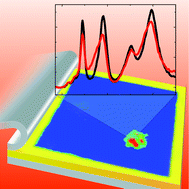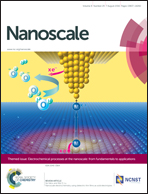Verification of redox-processes as switching and retention failure mechanisms in Nb:SrTiO3/metal devices†
Abstract
Nanoscale redox reactions in transition metal oxides are believed to be the physical foundation of memristive devices, which present a highly scalable, low-power alternative for future non-volatile memory devices. The interface between noble metal top electrodes and Nb-doped SrTiO3 single crystals may serve as a prominent but not yet well-understood example of such memristive devices. In this report, we will present experimental evidence that nanoscale redox reactions and the associated valence change mechanism are indeed responsible for the resistance change in noble metal/Nb-doped SrTiO3 junctions with dimensions ranging from the micrometer scale down to the nanometer regime. Direct verification of the valence change mechanism is given by spectromicroscopic characterization of switching filaments. Furthermore, it is found that the resistance change over time is driven by the reoxidation of a previously oxygen-deficient region. The retention times of the low resistance states, accordingly, can be dramatically improved under vacuum conditions as well as through the insertion of a thin Al2O3 layer which prevents this reoxidation. These insights finally confirm the resistive switching mechanism at these interfaces and are therefore of significant importance for the study and application of memristive devices based on Nb-doped SrTiO3 as well as systems with similar switching mechanisms.

- This article is part of the themed collection: Electrochemical processes at the nanoscale: from fundamentals to applications


 Please wait while we load your content...
Please wait while we load your content...